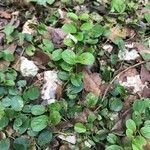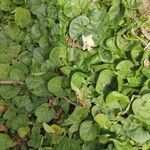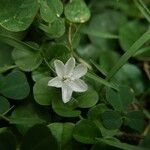A perennial herb. Stems few to several, prostrate and rooting at the nodes, slender, 10-40 cm long, with patent hairs, glabrescent. Leaves distichous, mostly broadly ovate, elliptic or orbicular, 4-15(-25) by 3-15(-18) mm, rounded, truncate or subcordate at the base, rounded or emarginate at the apex, glabrous on both sides or appressed-pilose beneath; petiole 1—5(-12) mm long. Flowers 1 or 2 in the leaf-axils; peduncle none or very short; pedicels 2-6 mm long. Bracts linear or lanceolate, ½-1½ mm long. Sepals ovate-oblong to oblong, obtuse or acutish, 2½-4 mm long, sparsely pilose or glabrous, the margins ciliate. Corolla rotate to broadly funnel-shaped, white, the distinctly lobed limb c. 8 mm diam. Ovary glabrous. Capsule globular, glabrous, 4-valved. Seeds 4 or less, black or brown.
Perennial herb. Stems prostrate, pubescent, rooting at nodes. Leaves orbicular to orbicular-obovate, 5-20 mm long and broad, apex obtuse or retuse, base truncate to subcordate, glabrous or sparsely pubescent beneath; petiole 1-8 mm long, pubescent, canaliculate above. Flowers solitary or rarely paired, axillary; peduncles up to 5 mm long, recurving. Sepals ovate to elliptic-ovate, 2.5-3.0 x 1.5 mm, subacute to acute, pubescent or glabrescent with ciliate margins. Corolla white, subrotate, 4.5 mm long, 6 mm wide, deeply lobed; lobes obovate, 1.5-2.5 mm long, 1.0-1.5 mm broad. Capsule globose, 3-4 mm in diameter, 1-locular, bivalved, (2-)4-seeded. Seeds subglobose, 1.5-2.0 mm long, brown to black, shiny.
Perennial herb; stems prostrate, rooting at the nodes, pubescent.. Leaf-blade orbicular or orbicular-obovate, 5–18 mm. long and broad, obtuse or retuse at the apex, subcordate at the base, glabrous or sparingly pubescent beneath; petiole 1–6 mm. long, pubescent, channelled above.. Flowers solitary or rarely paired, axillary; peduncles ± 2 mm. long.. Sepals elliptic-ovate, 2.5–3 mm. long, 1.5 mm. wide, ± acute, pubescent or glabrescent.. Corolla white, subrotate, 4.5 mm. long, 6 mm. in diameter, deeply lobed; the lobes obovate, 1.5–2 mm. long, 1–1.5 mm. broad.. Capsule globose, 3–4 mm. in diameter, 1-locular, 2-valved, 4-seeded.. Seeds brown to black, subglobose, 1.5–2 mm. long.. Fig. 4.
Perennial herbs; stems prostrate, herbaceous, rooting at nodes, pilose with short trichomes to glabrate. Leaves broadly ovate to orbicular, 4-15 mm long, short-petiolate, rounded to emarginate apically, rounded to subcordate basally, glabrous or somewhat pubescent beneath. Flowers solitary or paired in leaf axils, pedicels 2-6 mm long; sepals elliptic-ovate to ovate-oblong, 2.5-4 mm long, pubescent, glabrescent, ciliate; corollas white, 5-7 mm broad; ovary glabrous. Fruits capsular, globose, 3-4 mm in diameter, reflexed; seeds brown to black, subglobose, slightly muricate.
A herb. It keeps growing from year to year. There are several stems and they form roots at the nodes. They lie along the ground. They are 20-40 cm long. The leaves are almost round and 2 cm long by 1 cm wide. The fruit is a flattened round capsule with 2 sections and 4 valves and 1-3 seeds.
Leaf-lamina circular or circular-obovate, 5–20 mm. long and broad, apex very obtuse, base truncate to subcordate, glabrous or sparingly pubescent beneath; petiole 1–8 mm. long, pubescent, canaliculate above.
Sepals ovate to ellipti-covate, 2·5–3 × 1·5 mm., more or less acute, pubescent or glabrescent with ciliate margins.
Corolla white, subrotate, about twice as long as the calyx, deeply lobed; lobes obovate, 1·5–2·5 × 1–1·5 mm.
Flowers solitary or rarely paired, axillary; peduncles up to 5 mm. long, recurving.
Capsule globose 3–4 mm. in diam., unilocular, bivalved, 4 (2)-seeded.
Seeds brown to black, subglobose 1·5–2 mm. long, shining.
Perennial herb with the same habit as Dichondra repens.
Stems prostrate, rooting at the nodes, pubescent.






